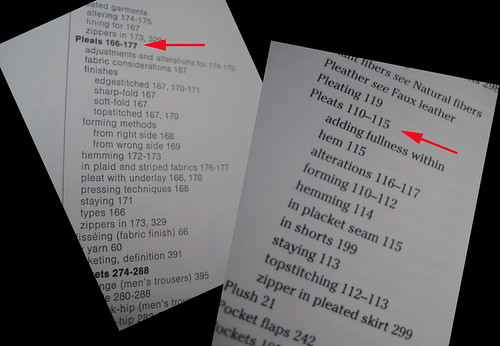I got the original Reader's Digest Complete Guide to Sewing a couple of months ago at the thrift store. I knew the new one was coming out as well but for $2.62 I snatched it up in a heartbeat. My library got the newest version so of course I was all over taking a look at it as well.
Just recently I needed to look up some information on pleats. Great time to compare. After thumbing through both of the books a lot of the pictures and information are exactly the same. There are a few differences though (this really pertains to the pleats section as I did not thumb through and compare the whole book).
First we will take a look at the Index and you can see there is an obvious difference in the number of pages dedicated to pleats. Twelve pages of content in the original versus six in the new version.Here is the content difference:
Vintage 1976 Version
-page of different types of pleats
-page of fabric considerations for pleats
-section on pleating on plaid fabrics (never even considered this, interesting)
-section on estimating amount of fabric needed
2011 Version
-has a pleated skirt pattern at end of segment
-color pictures
It appears contentwise everything in the 2011 version except the pattern is in the 1976 version. You can see the 1976 version has a few more details which to me are important fundamental details. The new version also has color pictures and nice glossy pages but when it comes down to the content section for pleats, I'll stick with the original.
Vintage 1976 Version
-page of different types of pleats
-page of fabric considerations for pleats
-section on pleating on plaid fabrics (never even considered this, interesting)
-section on estimating amount of fabric needed
2011 Version
-has a pleated skirt pattern at end of segment
-color pictures
It appears contentwise everything in the 2011 version except the pattern is in the 1976 version. You can see the 1976 version has a few more details which to me are important fundamental details. The new version also has color pictures and nice glossy pages but when it comes down to the content section for pleats, I'll stick with the original.
Anyone have both the old and newer versions of this book? Which do you prefer?

Old sewing books, hands down.
ReplyDeleteI think there has become a sharper divide between "hobby" and "professional" sewing, with more of an assumption that home sewers don't need professional results. Some of it may be the way sewing machines have advanced. Most serious home sewers now will have at least a serger in addition to the basic machine, but if they write a general sewing book on the assumption that the readers will have a serger, they'll be leaving out a big part of their target audience. An older sewing book can sufficiently cover beginner through advanced techniques with only one machine.
Plus, back when a large portion of women were homemakers, sewing was more likely to be something done at home for practical reasons-- many home sewers were really semi-professional. It created a different view on what should be included in a sewing book. Now they need to make it fun and relaxing, so they're likely to leave out anything more complicated.